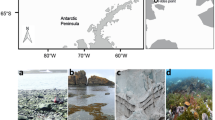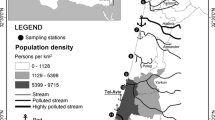Abstract
Abandoned and recent shell middens were compared from Inhaca island, Mozambique, to investigate the impact of human exploitation. The growing human population was expected to increase the exploitation pressure, decrease the mean shell size, and increase the species diversity. Moreover, exploitation-vulnerable species were expected to disappear from recent middens. 29252 shells were collected from 6 recent and 8 abandoned middens, comprising 78 species, the majority bivalves. Pinctada nigra was the most abundant. The mean shell size was significantly smaller in recent middens, and the conspicuous, surface-dwelling gastropod Terebralia palustris showed the largest size reduction. Size reduction was related with the life history of the species. Older, abandoned middens had a larger species richness, refuting the intermediate disturbance hypothesis. The species composition of recent and abandoned middens was relatively similar, which was probably caused by low human exploitation pressure and the substrate characteristics. The disappearance of the mussel Perna perna was thought to be related to overexploitation.
Similar content being viewed by others
References
Addessi L (1994) Human disturbance and long-term changes on a rocky intertidal community. Ecol Appl 4: 786–797
Anderson AJ (1981) A model of prehistoric collecting on the rocky shore. J Archaeol Sci 8: 109–120
Bailey GN (1978) Shell middens as indicators of postglacial economies: a territorial perspective. In: Mellars P (ed.), The Early Postglacial Settlement of Northern Europe: an Ecological Perspective. University of Pittsburgh Press, Pittsburgh, pp. 37–63
Barradas (1967) Concheiros da Ántiga Baía de Lourenço Marques. Trabalhos de Instituto de Investigação Científica no 17. Instituto de Investigação Científica, Maputo
Bettinger RL and Malhi R (1997) Central place models of acorn and mussel processing. J Archaeol Sci 24: 887–899
Bigalke EH (1973) The exploitation of shellfish by coastal tribesmen of the Transkei. Ann Cape Prov Mus 9: 159–175
Bird DW and Bliege Bird RL (1997) Contemporary shellfish gathering strategies among the Meriam of the Torres Strait Islands, Australia: testing predictions of a central place foraging model. J Archaeol Sci 24: 39–63
Blake RW (1979) On the exploitation of a natural population of Nereis virens Sars from the North-East coast of England. Estuar Coast Mar Sci 8: 141–148
Branch GM (1975) Notes on the ecology of Patella concolor and Cellana capensis, and the effects of human consumption on limpet populations. Zool Afr 10: 75–85
Branch GM and Moreno CA (1994) Intertidal and subtidal grazers. In: Siegfried WR (ed.), Rocky Shores: Exploitation in Chile and South Africa. Springer-Verlag, Berlin, pp. 75–100
Catterall CP and Poiner IR (1987) The potential impact of human gathering on shellfish populations, with reference to some NE Australian intertidal flats. Oikos 50: 114–122
Clarke KR and Warwick RM (1994) Change in Marine Communities; an Approach to Statistical Analysis and Interpretation. Plymouth Marine Laboratory, Plymouth
Connell JH (1978) High diversity of trees and corals is maintained only in a nonequilibrium state. Science 199: 1302–1310
de Boer WF and Longamane FA (1996) The exploitation of intertidal food resources in Inhaca bay, Mozambique. Biol Cons 78: 295–303
de Boer WF and Prins HHT (in prep.)Macrofauna community structure on the mudflats of Inhaca Island, Mozambique, is unaffected by human exploitation: evidence for the absence of key stone species.
de Boer WF, Blijdenstein A-F and Perreira T (submitted) Prey choice, habitat choice, and timing of people exploiting intertidal resources, explained with optimal foraging models. Evol Ecol
Deith MR (1986) Subsistence strategies at a mesolithic camp site: evidence from stable isotope analyses of shells. J Archaeol Sci 13: 61–78
Durán LR and Castilla JC (1989) Variation and persistence of the middle rocky intertidal community of central Chile, with and without human harvesting. Mar Biol 103: 555–562
Dye AH, Lasiak TA and Gabula S (1997) Recovery and recruitment of the brown mussel, Perna perna (L.), in Transkei: implications for management. S Afr J Zool 32: 118–123
Fernandez Mand Castilla JC (1997) The chilean artisanal stone crab (Homalaspis plana) fishery: catch trends in open access zones and the effect of management areas in Central Chile. J Shellf Res 16: 371–377
Griffiths CL and Branch GM (1997) The exploitation of coastal invertebrates and seaweeds in South Africa: historical trends, ecological impacts and implications for management. Trans. Roy Soc S Afr 52: 121–148
Hockey PAR and Bosman AL (1986) Man as an intertidal predator in Transkei: disturbance, community convergence and management of a natural food resource. Oikos 46: 3–14
Hockey PAR, Bosman AL and Siegfried WR (1988) Patterns and correlates of shellfish exploitation by coastal people in Transkei: an enigma of protein production. J Appl Ecol 25: 353–363
Kalk M (1995) A Natural History of Inhaca Island. Witwatersrand University Press, Johannesburg
Keough MJ, Quinn GP and King A (1993) Correlations between human collecting and intertidal mollusc populations on rocky shores. Biol Conserv 7: 378–390
Krebs CJ (1989) Ecological Methodology. HarperCollins, New York
Kyle R, Pearson B, Fielding PJ, Robertson WD and Birnie SL (1997) Subsistence shellfish harvesting in the Maputaland Marine Reserve in Northern Kwazulu-Natal, South Africa: rocky shore organisms. Biol Conserv 82: 183–192
Kyle R, Robertson WD and Birnie SL (1997) Subsistence shell-fish harvesting in the Maputaland Marine Reserve in Northern Kwazulu-Natal, South Africa: sandy beach organisms. Biol Conserv 82: 173–182
Lasiak T (1991a) The susceptibility and/or resilience of rocky littoral molluscs to stock depletion by the indigenous coastal people of Transkei, Southern Africa. Biol Conserv 56: 245–264
Lasiak T (1991b) Is there evidence of over-exploitation of mussel stocks on the Transkei coast? S Afr J Mar Sci 10: 299–302
Lasiak T (1992) Contemporary shellfish-gathering practices of indigenous coastal people in Transkei: some implications for interpretation of the archaeological record. S Afr J Sci 88: 19–28
Lasiak T (1993) The shellfish-gathering practices of indigenous coastal people in Transkei: patterns, preferences and perceptions. S Afr J Ethnol 16: 115–120
Lasiak T (1998) Multivariate comparison of rocky infratidal macrofaunal assemblages from replicate exploited and non-exploited localities on the Transkei coast of South Africa. Mar Ecol Prog Ser 167: 15–23
Lasiak TA and Field JG (1995) Community-level attributes of exploited and non-exploited rocky infratidal macrofaunal assemblages in Transkei. J Exp Mar Biol Ecol 185: 33–53
Levene H (1960) Robust Tests for Equality of Variances. In: Olkin I, Ghurye SG, Hoeffding W, Madow WG and Mann HB (eds.), Contributions to Probability and Statistics. Stanford University Press, Stanford, pp. 278–292.
Lopes LL (1985) A Ilha da Inhaca; O Crescimento Populacional e o Impacto nas Condições Naturais. Universidade Eduardo Mondlane, Maputo
Lopes LL (1991) Ilha da Inhaca-Moçambique: Estimativas de Fecundidade e de Mortalidade a Partir dos Censos de 1980 e de 1985. Universidade Federal de Minas Gerais, Belo Horizonte
McLusky DS, Anderson FE and Wolfe-Murphy S (1983) Distribution and population recovery of Arenicola marina and other benthic fauna after bait digging. Mar Ecol Prog Ser 11: 173–179
Mellars P (1978) The Early Postglacial Settlement of Northern Europe. University of Pittsburgh Press, Pittsburgh
Menge BA (1995) Joint 'bottom-up' and 'top-down' regulation of rocky intertidal algal beds in South Africa. Tree 10: 431–432
Menge BA, Berlow EL, Blanchette CA, Navarrete SA and Yamada SB (1994) The keystone species concept: variation in interaction strength in a rocky intertidal habitat. Ecol Monogr 64: 249–286
Menge BA and Farrell TM (1989) Community structure and interaction webs in shallow marine hard-bottom communities: tests of an environmental stress model. Adv Ecol Res 19: 189–262
Metcalfe D and Barlow KR (1992) A model for exploring the optimal trade-off between field processing and transport. Am Anthrop 94: 340–356
Morais JM (1988) The Early Farming Communities of Southern Mozambique. Studies in African Archeology 3. Eduardo Mondlane University, Maputo
Moreno CA, Sutherland JP and Jara HF (1984) Man as a predator in the intertidal zone of southern Chile. Oikos 42: 155–160
Parkington J (1976) Coastal settlement between the mouths of the Berg and Olifants Rivers, Cape Province. S Afr Archaeol Bull 31: 127–140
Robertson WD (1996) Abundance, population structure and size at maturity of Scylla serrata (Forskål) (Decapoda: Portunidae) in Eastern Cape estuaries, South Africa. S Afr J Zool 31: 177–185
Sharpe AK and Keough MJ (1998) An investigation of the indirect effects of intertidal shellfish collection. J Exp Mar Biol Ecol 223: 19–38
Siegel S and Castellan NJ (1988) Nonparametric Statistics for the Behavioral Sciences. McGraw-Hill, New York
Siegfried WR (ed.) (1994) Rocky Shores: Exploitation in Chile and South Africa. Springer-Verlag, Berlin
Siegfried WR, Hockey PAR and Branch GM (1994) The Exploitation of Intertidal and Subtidal Biotic Resources of Rocky Shores in Chile and South Africa-An Overview. In: Siegfried WR (ed.), Rocky Shores: Exploitation in Chile and South Africa. Springer-Verlag, Berlin, pp. 1–15
Siegfried WR, Hockey PAR. and Crowe AA (1985) Exploitation and conservation of brown mussel stocks by coastal people of Transkei. Env Cons 12: 303–307
Swadling P (1976) Changes induced by human exploitation in prehistoric shellfish populations. Mankind 10: 156–162
Thackeray JF (1988) Molluscan fauna from Klasies River, South Africa. S Afr Archaeol Bull 43: 27–32
van Erkom Schurink C and Griffiths CL (1990) Marine mussels of Southern Africa-their distribution patterns, standing stocks, exploitation and culture. J Shellf Res 9: 75–85
Voigt EA (1975) Studies of marine mollusca from archaeological sites: dietary preferences, environmental reconstructions and ethnological parallels. In: Clason AT (ed.), Archaeozoological Studies. Elsevier, Amsterdam, pp. 87–98
Volman TP (1978) Early archeological evidence for shellfish collecting. Science 201: 911–913
Zar JH (1984) Biostatistical Analysis. Prentice Hall, London
Author information
Authors and Affiliations
Rights and permissions
About this article
Cite this article
de Boer, W., Pereira, T. & Guissamulo, A. Comparing recent and abandoned shell middens to detect the impact of human exploitation on the intertidal ecosystem. Aquatic Ecology 34, 287–297 (2000). https://doi.org/10.1023/A:1009957409421
Issue Date:
DOI: https://doi.org/10.1023/A:1009957409421




